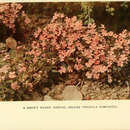Distribution in Egypt
provided by Bibliotheca Alexandrina LifeDesk
Mediterranean region and Sinai.
- author
- BA Cultnat
- provider
- Bibliotheca Alexandrina
Global Distribution
provided by Bibliotheca Alexandrina LifeDesk
North Africa, Sinai, Italy,Naturalized in Europe.
- author
- BA Cultnat
- provider
- Bibliotheca Alexandrina
Comments
provided by eFloras
Silene pendula is an attractive, rarely escaping and persisting garden plant readily recognized by its beautiful pink flowers, straggling leafy stems, racemelike inflorescences with axillary flowers, and the obovoid, papery, strongly veined calyx that is constricted below the middle. It is occasionally used in seeding roadsides.
- license
- cc-by-nc-sa-3.0
- copyright
- Missouri Botanical Garden, 4344 Shaw Boulevard, St. Louis, MO, 63110 USA
Description
provided by eFloras
Plants annual, with several decumbent shoots; taproot slender. Stems procumbent to ascending, branched, leafy, 15-45 cm, lanuginose, often sparsely so, viscid distally. Leaves 2 per node; proximal with blade obovate, spatulate, apex obtuse; distal sessile, blade ovate to lanceolate, 2-5 cm × 2-20 mm, apex acute, sparsely pubescent adaxially, more densely so abaxially. Inflorescences pseudoracemose, lax, solitary flowers in axils of leafy bracts. Pedicels erect in flower, sharply deflexed at base in fruit, usually shorter than calyx, pilose and stipitate-glandular. Flowers: calyx prominently 10-veined, obovoid, especially in fruit, clavate, constricted around carpophore and narrowed at mouth, umbilicate, inflated, 13-18 mm, loose and papery, pubescence glandular and eglandular, sparsely lanuginose, veins parallel, green or purple, with pale commissures, lobes triangular, ca. 2 mm, apex obtuse; corolla bright pink, clawed, claw equaling calyx, limb obtriangular, 2-lobed, 7-11 mm, lobes divergent, ovate, appendages 2, shorter than 1 mm, apex acute; stamens slightly longer than petal claw; stigmas 3, equaling petals. Capsules included in calyx, ovoid-conic, opening by 6 teeth; carpophore 3-6 mm. Seeds dark brown, broadly reniform, 1.3-1.5 mm, with concentric crescents of shallow tubercles on both sides, margins with larger, deeper tubercles. 2n = 24 (Europe).
- license
- cc-by-nc-sa-3.0
- copyright
- Missouri Botanical Garden, 4344 Shaw Boulevard, St. Louis, MO, 63110 USA
Distribution
provided by eFloras
introduced; B.C.; Calif., Maine, N.J., N.Y., Oreg., Wyo.; Europe.
- license
- cc-by-nc-sa-3.0
- copyright
- Missouri Botanical Garden, 4344 Shaw Boulevard, St. Louis, MO, 63110 USA
Silene pendula: Brief Summary
provided by wikipedia EN
Silene pendula, called the nodding catchfly or drooping catchfly, is a species of flowering plant in the genus Silene, native to Italy, Greece, and Turkey, and introduced to scattered locations in North America, South America, Africa, Europe and Asia. A number of cultivars are available. A 2020 study showed with certainty that, despite their morphological similarities, Silene cisplatensis is not synonymous with Silene pendula.
- license
- cc-by-sa-3.0
- copyright
- Wikipedia authors and editors

